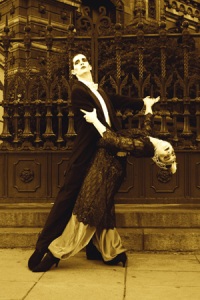
The music of Argentinean composer Julian Plaza (1928-2003) has a special place in the history of Tango. Plaza was an all-round musician. He was bandoneon-player and pianist for some of Argentina’s top orchestras in the late 1940’s including the legendary ensembles of Carlos di Sarli and Osvaldo Pugliese. As arranger of existing tangos, he honed his craft in the 1950’s, working with the tango giants such as Anibal Troilo and Osvaldo Pugliese. Plaza left a canon of very fine and original tangos. He was influenced by Piazzolla and the Tango Nuevo. Which tanguero was not? But Plaza was not drawn into the heady world of Tango Nuevo. Instead, Plaza was determined that the Tango should not stray too far from its roots as “dance music”. During his association with the music of Pugliese – a composer who more than hinted at the avant-garde that would be unleashed on the tango in the 1950s – he undoubtedly absorbed a taste for jarring harmonies and aggressive cross-rhythms. His music is spicy with cross rhythms and dissonance, but remains dance music per excellence.
Payadora is a delightful mixture of old and new. This uninhibited milonga has an obsessive rhythm that only abates for a moment, before it is off for another whirl around the dance-floor. The sharp accents in the rhythm and the spicy chords, both depict and inspire sharp stabs of the shoe, and those delightful moves where the leader “blocks” the foot of the follower in a sharp and percussive movement.
In our recording on TANGO CLUB we recreate the atmosphere of the dance-hall. We do not use a drummer on this track, as the style does not seem to call for that kind of groove. We all hit and tap the basic rhythm of this fast Milonga on various parts of our instrument. This serves to announce the type of dance to the audience, they can instantly decide if they are in the mood for a fast whirl around the floor, and the man can spot the woman of his choice. The music starts with an optimistic run up the scale, immediately dissolving into a short little oasis where there is hardly any definable rhythm. Here, the dancers take up their position, clasp hands and “tune in” to one another in the close embrace of the Argentinean Tango. The leader “tests” the balance of his follower, making sure he or she is prepared for which foot the leader will be stepping from.
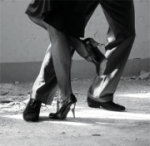
You can read more about how the milonga is danced, and watch video examples of this, in a delightful “Tango Jargon” blog by “Scott and Niki”.
Where does the Milonga come from?

The term milonga comes from a similar expression that means “lyrics”. The Milonga is also derived from singing and originated in the Río de la Plata area of Argentina and Uruguay. A Payadora is an “itinerant singer” or wandering minstrel”, so the title of Plaza’s tango refers also to its vocal history.
Forms of European dance-music such as the Polka, made their way to Argentina with emigrants and was extremely popular in the 1870s. The song was set to a lively 2/4 tempo, and often included musical improvisation. Over time, dance steps and other musical influences were added, eventually giving rise to the tango.
Macho Milonga
In the first decade of the 20th Century, men outnumbered women in Buenos Aires by 8 to 1. Both licensed and unlicensed prostitution was rife in the port city. Women with whom to experience the pleasures of the body (dancing included) were at a premium. When some of the more respected members of society visited the brothels – viewed as a necessary evil given the circumstances – musicians were sometimes asked to blindfold themselves, to protect the identity, if not the “dignity” of the customer. I suspect that this practice of playing sightless, might also have influenced the musical development of the Milonga style. The phrases and chords make physical sense in a way that many other tango styles do not. Even the trickier milongas have a physical character in the basic material that leans itself to small movements on the piano. This somehow encourages one to invent little variants on the themes.
To illustrate exactly this part of the Tango’s history, the CT TANGO ENSEMBLE have in fact performed a Milonga blindfolded at the Klein Karoo Nationale Kunstefees. All You ever Wanted To Know About Tango But Were Too Afraid To Ask, scripted and directed by Mark Hoeben, ran to sold out houses at the KKNK and the “Blindfolded Tango” was one of the highlights of the show. It was quite a showpiece for our ensemble, in which our group – of four men – realized that while we were showing off in the best possible way, we also “danced” with each other in the way we make music together.
Marthinus Basson won a Fleur du Cap Best Director award in 2002 for the show, Tango Del Fuego – “a boundary-defying history of tango filled with the form’s founding impetus of rapine colonialism, forced removal and slavery.” (Darryl Accone – Artslink.co.za)
Starring the cream of South African Theatre such as Nicole Holm and the magnificent ensemble of Antoinette Kellermann and David Minnaar, it ran at all the major arts festivals in South Africa. The music – the glue which unified the show, was provided by the CT Tango Ensemble. The multi-talented Maxwell Xolani-Rani paid homage to the slave-roots of the Tango by dancing a Milonga with a drum. The energy of that dance by a solo black male – dancing with and occasionally playing on the drum – was one of the highlights of the show. This work also exploited the same-sex tango duo. Again choreography and improvisation mingled in the work of Mark Hoeben and Jaco Bouwer to create a riveting tension. Aggressive sexuality, violence, testosterone, crimes of passion. These primal energies certainly float around the psyche of male tango dancers – if not males in general.
The Milonga then became the calling card of the macho male: only the best (male) dancers were “allowed” to dance with women, both socially, and as part of the formal procedures in the brothels. (Only in 1936 was legal prostitution abolished in Argentina). There is a well accepted tradition of same-sex tango Men practiced furiously with other men. And in the brothels, ladies were taught to dance by the other more experienced ladies. In Tango Del Fuego, the scene in which Ina Wichterich, taking the role of the older and wiser woman, teaches the rules of tango to inexperienced youth played by Nicole Holm, was poignant and touching.
Here you can watch a unique Video of a 72 year old Plaza performing a wonderfully creative and unusual version on this Tango, recorded in Bueons Aires in 2000:
Other useful links:
More posts on Payadora:
Plaza’s “Payadora” at the Cape Town Concert Series: Live Video 2013
Plaza’s “Payadora” at the Paulaner Music Festival: 2008
Watch a live iPhone video recording of Plaza’s Payadora performed the CT Tango Ensemble at the Lindbergh Arts Foundation in Muizenberg, Cape Town, in October 2010:
Watch Tanguero Anton Gazenbeek dance a magnificent solo tango with two sticks at a Milonga in New York:
Watch New York Tangueros Anton Gazenbeek and Sergio Segura dance an all-male duo tango at the same Milonga in New York.
Free Sheet Music of Julian Plaza can be downloaded at www.todotango.com.
Read more about West Hollywood dancer Steve Valentine’s same-sex ballroom dancing programme HERE.


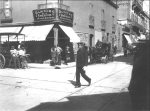
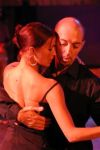
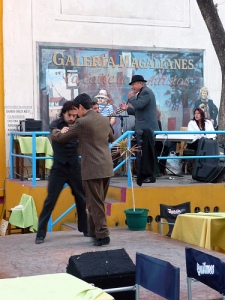

Leave A Comment
You must be logged in to post a comment.